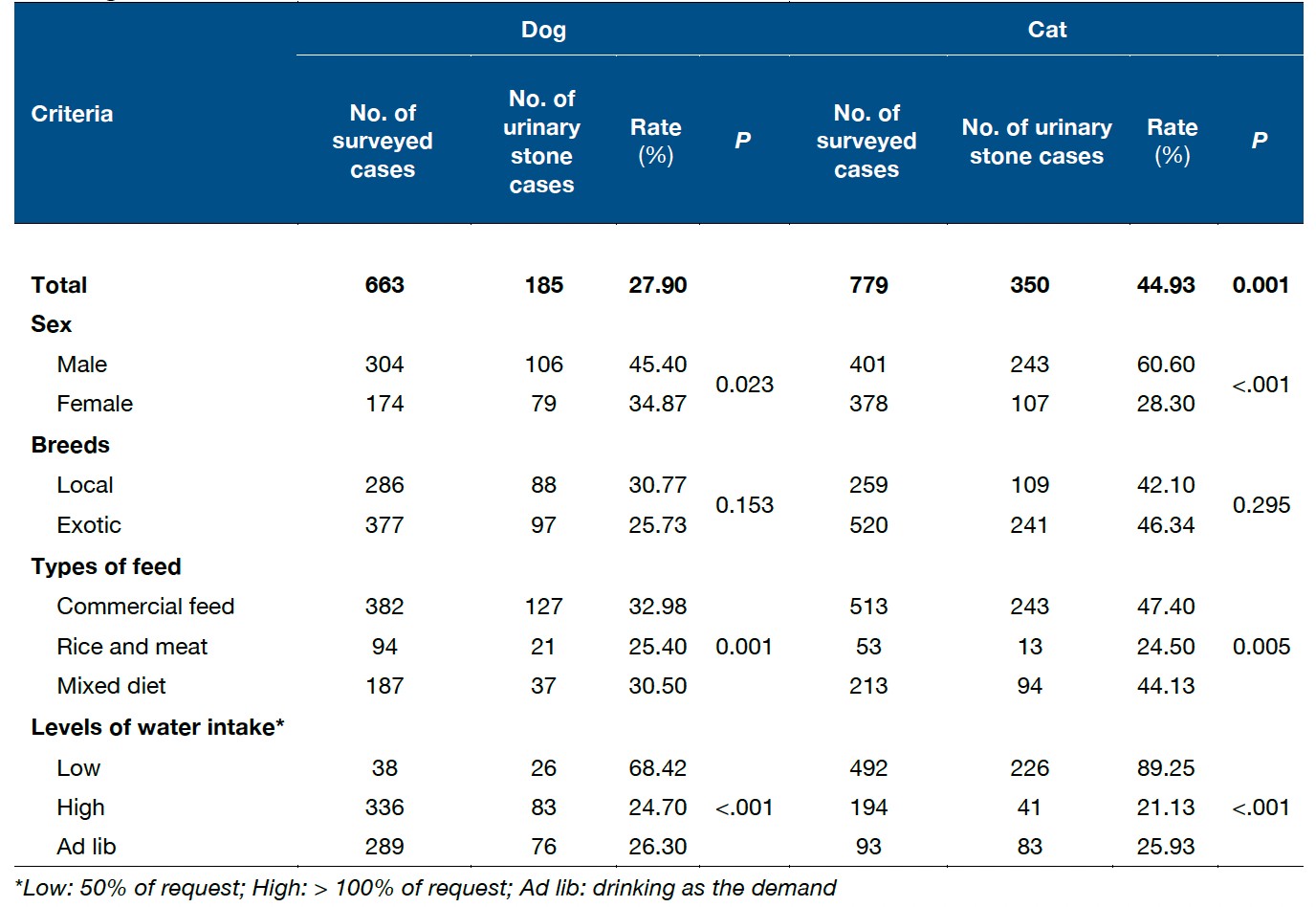Urolithiasis and the effectiveness of treatments in dogs and cats in Ho Chi Minh City, Viet Nam https://doi.org/10.12982/VIS.2025.057
Main Article Content
Abstract
This study aimed to investigate the prevalence of urolithiasis, analyze the chemical composition and anatomical location of the stone, and evaluate the effectiveness of treatments in dogs and cats. The investigation lasted one year in 7 Veterinary Clinics in the urban area of Ho Chi Minh City. Results show that urolithiasis accounted for 37.1% of total cases of dogs and cats, and that cats are more sensitive to urolithiasis than dogs (44.93% vs 27.90% of total population). Some risk factors such as sex, type of food and levels of drinking water affect urolithiasis rate, in which male animals and low levels of drinking water are more sensitive to urolithiasis than females and adequate levels. Lower urinary stones are common in dogs (74.05% of cases) and in cats (88.00% of cases). Struvite stones in dogs (62.00% of cases) and calcium oxalate in cats (56.00% of cases) are the most common type of urinary stones. Medical treatment is the most effective method to treat urolithiasis in cats and dogs.
Article Details

This work is licensed under a Creative Commons Attribution 4.0 International License.
Publishing an article with open access in Veterinary Integrative Sciences leaves the copyright with the author. The article is published under the Creative Commons Attribution License 4.0 (CC-BY 4.0), which allows users to read, copy, distribute and make derivative works from the material, as long as the author of the original work is cited.
References
Abreu, S.C., Gill, I.S., 2005. Advanced renal laparoscopy. BJU. Int. 95, 114–119.
Defarges, A., Evason, M., Dunn, M. and Berent, A., 2020. Urolithiasis in small animals. In: Bruyette, D.S., Bexfield, N., Chretin, J.D., Kidd, L., Kube, S., Langston, C., Owen, T.J., Oyama, M.A., Peterson, N., Reiter, L.V., Rozanski, E.A., Ruaux, C., Torres, S.M.F. (Eds.), Clinical small animal internal medicine. John Wiley & Sons, Hoboken, pp. 1123-1156.
Ergin, I., Sen, Y., Senel, O.O., Ozgermen, D.B., Bumin, A., 2018. Radiological and ultrasonographical evaluation of lower urinary tract diseases in cats. Ankara Univ. Vet. Fak. Derg. 65(1), 73-78.
Fogle, B., 2007. The Encyclopedia of the dog: the definitive visual guide. Dorling Kindersley, London, UK., pp. 1–416.
Gerber, B., Boretti, F. S., Kley, S., Laluha, P., Muller, C., Sieber, N., Unterer, S., Flucki- ger, M, Glaus, T., Reusch, C.E., 2005. Evaluation of clinical signs and causes of lower urinary tract disease in European cats. J. Small. Anim. Pract. 46, 571–577.
Gomes, V.R., Ariza, P.C., de Queiroz L.L., Fioravanti, M.C.S., 2022. Physicochemical techniques for determining the composition of canine and feline uroliths: a literature review. Cienc. Rural. 52(1), e20201116, 2022.
Koehler, L.A., Osborne, C.A., Buettner, M.T., Lulich, J.P., Behnke, R., 2009. Canine uroliths: frequently asked questions and their answers. Vet. Clin. North Am. Small Anim. Pract. 39(1), 161–181.
Langston, C., Gisselman, K., Palma, D., McCue, J., 2008. Diagnosis of urolithiasis. Compendium (Yardley, PA). 30(8), 447–455.
Le, P.N.N., Nguyen, M. K.T., Nguyen, L.H.T.V., 2024. Apply the ultrasonic method in the diagnosis of urologic diseases in dogs in Ho Chi Minh city. Can Tho Univ. J. Sci. 60(3b-2024), 155–162. (In Vietnamese)
Le, T.V., Tran, D.T., Ton, P.T., 2003. Application of ultrasound and X-ray in detecting bladder stones and results of surgical treatment on dogs. J. Vet. Sci. Technol. 2, 47–52. (In Vietnamese)
Lee, H.P., Leong, D., Heng, C.T., 2012. Characterization of kidney stones using thermogravimetric analysis with electron dispersive spectroscopy. Urol. Res. 40(3), 197–204.
Markwell, P.J., Robertson, W.G., Stevenson, A.E., 2000. Urolithiasis: a comparison of humans, cats and dogs. In Rodgers, A.L., Hibbert, B.E., Hess, B. (Eds.), Proceedings from the 9th International Symposium on Urolithiasis, University of Cape Town Cape Town, South Africa, pp. 785–788.
Mendoza-Lopez, C.I., Del-Agel-Caraza, J., Akr-Chnas, M.A., Quijano-Hernandez, I.A., Barbosa-Mirales, M.A., 2019. Epidemiology of urolithiasis in dogs from Guadalajara City, Mexico. Vet. Mex. 6(1), 1–14.
Nguyen, H.T.Q., Ho, Q.V., Dang, M.V., Nguyen, V.Q., Nguyen, T.T., 2022. Investigation of bladder problems in cats in Ho Chi Minh City. J. Agric. Dev. 21(5), 30–37. (In Vietnamese)
Osborne, C.A., Lulich J.P., Kruger, J.M., 1990. Medical dissolution of feline struvite urocystoliths. J. Am. Vet. Med. Assoc. 196(7), 1053–1068.
Pearle, M.S., Goldfarb, D.S., Assimos, D.G., Curhan, G., Denu-Ciocca, C.J., Matlaga, B.R., Monga, M., Penniston, K.L., Preminger, G.M., Turk, T.M., White, J.R., 2014. Medical management of kidney stones: AUA guideline. J. Urol. 192(2), 316–324.
Schaible, L., 2020. Bladder stones in cats: Types, Symptoms & Treatment. Available online: https://www.hillspet.com/cat-care/healthcare/bladder-stones-in-cats?light boxfired=true
Syme, H.M., 2012. Stones in cats and dogs: What can be learnt from them?. Arab J. Urol. 10(3), 230–239.
Tran, B.N., Nguyen, K.P., Tran, T.T., Nguyen, M.Y.T., Truong, V.P., Le, D.P.T., 2014. Epidemiological characteristics of urinary system disorders in dogs at Can Tho City. Can Tho Univ. J. Sci. (Special issue in agriculture - 2), 122–127. (In Vietnamese)
Ulrich, L.K., Kathleen, A.B., Lori, A.K., Laura, S., 1996. Urolith analysis: submission, methods, and interpretation. Vet. Clin. North Am. Small Anim. Pract. 26(2), 393–400.

